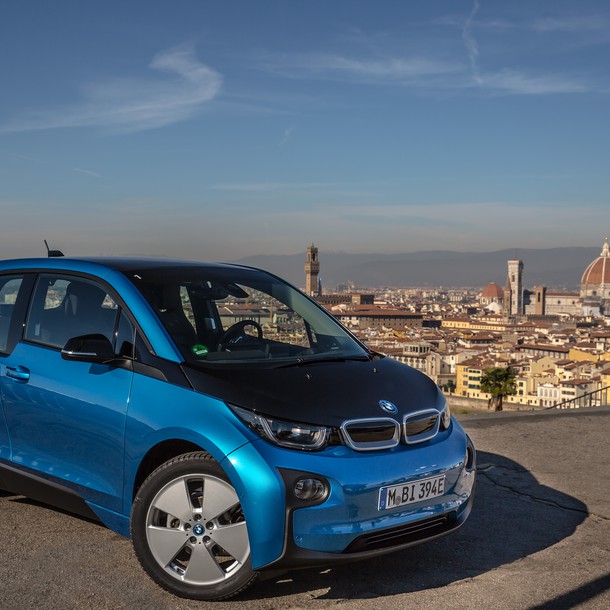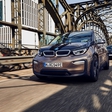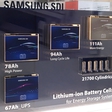
BMW i3 (94 Ah) with more powerful battery delivers a range of up to 200 kilometres under everyday conditions.
It is both exciting and challenging to imagine how we will live and move around in the future: how will society, the economy, living conditions – and therefore mobility – change? What possibilities will new technologies open up? How will digitalization and connectivity affect our automotive needs? All these were topics to discuss at two days meeting at Urban Mobility Symposium in Florence where BMW experts introduces a solution for urban mobility: the BMW i3 94Ah.

The BMW i3 (94 Ah) has a capacity of 33 kilowatt hours (kWh) thanks to the higher storage density of the lithium ion cells. The battery dimensions remain unchanged with over 50 per cent range increase in the standard NEDC cycle which equals 300 kilometres instead of 190 kilometres. Even in everyday use, in bad weather conditions and with the air conditioning or heating turned on, 200 kilometres of range can be achieved on one full battery charge. The driving performance figures of the 125 kW/170 hp hybrid synchronous electric motor remain virtually unchanged. The motor propels the BMW i3 from 0 to 100 km/h in 7.3 seconds. This makes the BMW i3 both the sportiest and most efficient electric vehicle in its segment with an electricity consumption of 12.6 kWh/100 km (NEDC). The BMW i3 with 60 Ah battery, which has been on the market for two years, remains part of the model range. In addition, the model variant with Range Extender will still be available for both battery versions. The 2-cylinder petrol engine keeps the charge level of the battery constant while driving provides an additional range of 150 kilometres (BMW i3 (94 Ah)/BMW i3 (60 Ah): combined fuel consumption 0.6./0.6l/100 km; combined electricity consumption: 11.3/13.5 kWh/100 km; combined CO2 emissions: 12/13 g/km).

The high-voltage battery consists of eight modules with twelve storage cells each and its capacity has increased significantly without any changes in exterior dimensions. By optimising the cell-internal packages with more electrolyte and adapting the active material, BMW and Samsung SDI have succeeded in increasing cell capacity to 94 Ah and overall battery energy to 33 kWh of which 27 kWh can be effectively used. The battery of the BMW i3 (60 Ah) produces 22 kWh (gross)/19 kWh (net).

Retrofit programme: the battery can be exchanged optionally
The main focus at BMW i is on sustainability. The customer is given the assurance that his BMW i3 can be adapted to the latest technical developments in a resource-saving way. This is safe-guarded by the flexible LifeDrive vehicle architecture. This is the first automobile in the premium compact segment in the world to have been designed from scratch as a purely electrically powered vehicle. This design also includes retrofitting new battery technologies. With the introduction of the new 94 Ah battery, BMW gives BMW i customers the opportunity of retrofitting their purely electric BMW i3 (60 Ah) with the new 33 kWh battery as part of a high-voltage retrofit programme. This programme is available in selected markets. The 22 kWh batteries traded-in by customers are used to build stationary storage battery modules thus starting their second life. This effectively proves how sustainable BMW i technology is across its entire production and service life cycle.
New, faster charging electronics: three-phase charging up to 11 kW
In principle, a 50 percent higher battery capacity would also mean longer charging times – if the charging technology had not been adapted to the new requirements. In order to keep up with the increased battery capacity when charging with alternating current (AC), the AC fast charging system was developed. With the new 94 Ah battery, multi-phase AC charging is extended to 11 kW charging capacity and thus is in line with the charging capacity standards widely used in the public charging infrastructure. This represents a 50 percent increase compared to the BMW i3 (60 Ah). The 60 Ah model can be charged using single-phase alternating current at 7.4 kW. This means the charging time for the BMW i3 (94 Ah) is less than three hours, in spite of the significantly larger battery capacity – which is the same time it takes for today's 60 Ah battery at 7.4 kW charging current.

Comfortable home charging: the new BMW i Wallboxes
With the introduction of the BMW i3 (94 Ah) in summer 2016, BMW i will be offering a new BMW i Wallbox worldwide for comfortable and fast home garage charging or charging on a private parking space. This Wallbox has been adapted to the new charging technology and in addition to single-phase operation now also offers a charging capacity of up to 22 kW in three-phase operation. The new Wallbox is characterised by a flatter and more compact design compared to its predecessor, but thanks to its increased performance can now charge the battery in two hours and 45 minutes. The charging process starts automatically as soon as the car and charging cable are connected. The BMW i Wallbox is operated using an LED interface. At the end of 2016 two additional Wallboxes will be available offering additional comfort and connected functions. This permits private or fleet customers to adapt the Wallboxes precisely to the needs of their different number of vehicles. Among other things the BMW i Wallbox Plus automatically detects the connected vehicles and associates the relevant charge data using a local smartphone app.
In order to make BMW Group is fit for the future, the Company continuously invests in integrating sustainability into our business model. ""If, as a designer, you are able to imagine something, there's a good chance it could one day become reality. So our objective with the BMW VISION NEXT 100 was to develop a future scenario that people would engage with. Technology is going to make significant advances, opening up fantastic new possibilities that will allow us to offer the driver even more assistance for an even more intense driving experience. My personal view is that technology should be as intuitive as possible to operate and experience so that future interactions between human, machine and surroundings become seamless," said Adrian van Hooydonk, Head of BMW Group Design at Palazzo Strozzi in Florence.



